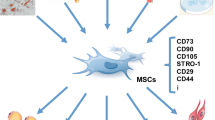Abstract
Bone formation was induced by iso- and home-implantation of lyophilized mouse osteosarcoma, in which an osteogenic activity is observed. The inducing factor is present exclusively in osteosarcoma, such as BF and Gardner, while not in non-osteogenic tumors, such as Ehrlich ascites tumor (2N & 4N) or mouse mammary carcinoma. The production of bone was rapid and extensive. It usually occurred within 21 days, and the time required for osteogenesis was almost the same as that reported in previous studies.
Similar content being viewed by others
References
Amitani, K.: Bone induction experiment. II. Histochemical observation of transfilter bone induction. J. Japan Orthop. Ass. (Tokyo)47, 1250–1252 (1973)
Anderson, H. C., Coulter, P. R.: Bone formation induced in mouse thigh by cultured human cells. J. Cell Biol.33, 165–177 (1967)
Anderson, H. C., Merker, P. C., Fogh, J.: Formation of tumors containing bone after intramuscular injection of transformed human amnion cells (FL) into cortisone-treated mice. Amer. J. Path.44, 507–512 (1964)
Annersten, S.: Experimentelle Untersuchungen über die Osteogenese und die Biochemie des Fracturcallus. Acta chir. scand.84, Suppl.60, 1–181 (1940)
Bertelsen, A.: Experimental investigations into postfoeta1 osteogenesis. Acta orthop. scand.15, 139–181 (1944)
Blessig: Über die Veränderungen der Niere nach Unterbinding der Nierenarterie. Arch. path. Anat. u. Physiol. u. klin. Med.16, 120–136 (1859)
Blum, G.: Phosphatase and the repair fractures. Lancet1944 II, 75–78
Burwell, R. G.: Studies in the transplantation of bone. VIII. J. Bone Jt Surg. B48, 532–566 (1966)
Chalmers, J.: Transplantation immunity in bone homografting. J. Bone Jt Surg. B41, 160–179 (1959)
Curtiss, P. H., Jr., Wilson, P. D.: A comparison of the healing of homogenous bank autogenous fresh bone grafts with and without the administration of cortisone. Surg. Gynec. Obstet.96, 155–161 (1953)
Friedenstein, A. Y.: Induction of bone tissue by transitional epithelium. Clin. Orthop.59, 21–37 (1968)
Goldhaber, P.: Osteogenic induction across millipore filters in vivo. Science133, 2065–2067 (1961)
Hartley, J., Tanz, S. S.: Experimental osteogenesis in rabbit muscle. Arch. Surg.63, 845–851 (1951)
Heinen, J. H., Jr., Dabbs, G. H., Mason, H. A.: The experimental production of ectopic cartilage and bone in the muscle of rabbits. J. Bone Jt Surg. A31, 765–775 (1949)
Heiple, K. G., Herndon, C. H., Chase, S. W., Wattleworth, A.: Osteogenic induction by osteosarcoma and normal bone in mice. J. Bone Jt Surg. A50, 311–325 (1968)
Huggins, C. B.: The formation of bone under the influence of epithelium of the urinary tract. Arch. Surg.22, 377–408 (1931)
Huggins, C. B., McCarroll, H. R., Blockson, B. H., Jr.: Experiments on the theory of osteogenesis. Arch. Surg.32, 915–931 (1936)
Huggins, C. B., Sammet, J. F.: Function of gall bladder epithelium as an osteogenic stimulus and the physiological differentiation of connective tissue. J. exp. Med.58, 393–400 (1933)
Lacroix, P.: Organizers and the growth of bone. J. Bone Jt Surg.29, 292–296 (1947)
Lacroix, P.: The organization of bones (trans. by S. Gilder). London: J. and A. Churchill Ltd. 1951
Levander, G.: A study of bone regeneration. Surg. Gynec. Obstet.67, 705–714 (1938)
Neuhof, H.: Fascia transplantation into visceral defects: An experimental and clinical study. Surg. Gynec. Obstet.24, 383–427 (1917)
Ray, R. D., Sabet, T. Y.: Bone grafts: Cellular survival versus induction. J. Bone Jt Surg. A45, 337–344 (1963)
Urist, M. R.: Bone formation by autoinduction. Science150, 893–899 (1965)
Urist, M. R., Dowell, T. A., Hay, P. H., Strates, B. S.: Inductive substrates for bone formation. Clin. Orthop.59, 59–96 (1968)
Urist, M. R., Silverman, B. F., Buring, K., Dubuc, F. L., Rosenberg, J. M.: The bone induction principle. Clin. Orthop.53, 243–283 (1967)
Wilson, P. D.: Experience with the use of refrigerated homogenous bone. J. Bone Jt Surg. B33, 301–315 (1951)
Wlodaraki, K.: The inductive properties of epithelial established cell lines. Exp. Cell Res.57, 446–449 (1969)
Wlodarski, K., Hiney, A., Ostrowski, K.: Investigation on cartilage and bone induction in mice grafted with FL and WISH line human amniotic cells. Calcif. Tiss. Res.5, 70–79 (1970)
Author information
Authors and Affiliations
Rights and permissions
About this article
Cite this article
Amitani, K., Nakata, Y. & Stevens, J. Bone induction by lyophilized osteosarcoma in mice. Calc. Tis Res. 16, 305–313 (1974). https://doi.org/10.1007/BF02008238
Received:
Accepted:
Issue Date:
DOI: https://doi.org/10.1007/BF02008238




